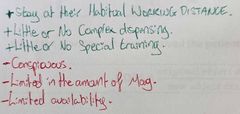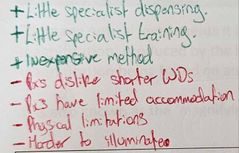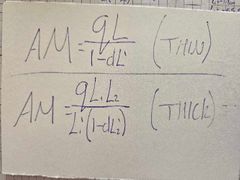![]()
![]()
![]()
Use LEFT and RIGHT arrow keys to navigate between flashcards;
Use UP and DOWN arrow keys to flip the card;
H to show hint;
A reads text to speech;
77 Cards in this Set
- Front
- Back
- 3rd side (hint)
|
What is visual acuity? |
The ability to resolve or discriminate spatially organised detail. |
|
|
|
What is Visual Field? |
Visual Field = The extent of the area in space in which objects are visible to an eye in a given position. |
|
|
|
Define low vision. |
The WHO dines low vision as VAs > 6/18. |
|
|
|
STATE the criteria for SI. |
SI - VA of 3/60 - 6/60 with a full visual field. - VA of up to 6/24 with a moderate reduction of the visual field, or with blurry/cloudy central vision. - VA of 6/18 or better with a gross field defect. |
|
|
|
STATE the criteria for SSI. |
SSI is classified into 3 groups. Group 1 - VA < 3/60 (but not 1/18) Group 2 - 3/60< VA <6/60 & a contracted field of vision. Group 3 - VA > 6/60 & have a severely contracted field of vision. (especially inferior or bi-temporal hemianopia) |
|
|
|
DEFINE Blind (SSI). |
"So blind that they cannot perform any work for which eyesight is essential" |
|
|
|
Define Partially Sighted (SI) |
"Substantially and permanently handicapped by defective vision caused by congenital defect, illness or injury" |
|
|
|
What is the route for registration for SI or SSI? |
1. OO/DO refers Px to eye clinic. 2. Consultant OO tests Px for eligibility. 3. Px signs CVI form, this is sent to Office of national statistics, GP & Local Authority. 4. Local Services contact Px and ask if they want to be on its confidential registers. 5. Px is issued with a registration card. 6. Local services arrange a Social Care and Rehabilitation Assessment, to assess Px's needs and discuss entitlements. |
|
|
|
STATE 5 benefits of being registered as SI and SSI. |
- Free NHS Sight Test. - Free/Reduced Bus Pass. - Disabled persons Rail Card. - Universal Credit. - Pension Credit. |
|
|
|
STATE is the difference between Certification and Registration. |
Registration is to be registered under a local authority. Certification is to be verified by a practitioner. |
|
|
|
What should be considered when thinking about visual function? |
- Binocularity - Colour Perception - Contrast Sensitivity (CS) - Duplicity Theory - Dark Adaption - Field Loss or Scotoma - Glare - Visual Acuity |
BCCDDFGV |
|
|
What is Contrast? |
The difference in colour and/or brightness of an object compared with the other objects in view. |
|
|
|
What is Contrast Sensitivity Function (CSF)? |
Contrast Sensitivity Function is an important measure of a person's ability to detect lower contrast stimuli. This is a good measure of how a person's visual function will operate in real-world conditions. |
|
|
|
How do you calculate contrast? |

|
|
|
|
How can CSF be measured? |
Gratings - These are vertical stripes of decreasing shades of black to grey. - The width between the Gratings can be changed to measure CS. - This can be used to plot a graph of the patients spatial frequency. |
|
|
|
List 5 conditions that can result in changes in CS. |
- Cataract and Strabismic Amblyopia. - Glaucoma. - Anisometropic Strabismus. - Defocus (ametropic) Blur. - Diffusive Blur / Disability Glare. - Retinal Atrophy / Defects. |
|
|
|
What is the major way to improve contrast? |
By improving illumination. |
|
|
|
What charts can be used to measure CS? |
- Pelli-Robson Chart - Bailey-Lovie Chart - Harsent NV Contrast Charts - VISTECH Charts - Electronic Charts |
|
|
|
Why do we measure CS? |
- It allows is to gauge visual performance under real-world conditions (Measure Visual Funtion). - Allows is to predict the likely success of LVAs. - Consider whether contrast advice and support are necessary. - Calculate contrast reserve, and feeds into our prescribing strategies. |
|
|
|
List 5 features of the Pelli-Robson Chart. |
- Large low-portability chart. - Must not get damaged / dirty/ marked. - All letter are the same size (subtend 2.8° at 1m). - 8 rows comprising of 2 triplets of letters. - Each triplet of letters has the same contrast. - Contrast reduces in a logarithmic progression. - Contrast reduces across and down the chart by 0.15 log units - Contrast ranges from 89% to 0.5%. |
|
|
|
How do you use a Pelli-Robson Chart? |
- Px is tested monocularly and the binocularly. - Should take no more than 8mins. - For use at 1m. - Centre of Chart should be approx. eye level with Px. - Chart should be illuminated as uniformly as possible. - Avoid Glare or reflections on the surface of the chart. - Illumination can be varied from 60-120cd/m². - Px should wear +1.00DS addition if AoA is not sufficient. - Px may require support and encouragement. - Px should guess even when they believe the letters are invisible. |
|
|
|
What is the Photopigment, Vision, and Location of the Rods? |
Photopigment = Rhodopsin.
Vision = Scotpic, Low Acuity, Achromatic.
Location = Highest density away from macula. |
|
|
|
What is the Photopigment, Vision, and Location of the Cones? |
Photopigment = Red, Blue Green. Vision = Photopic, High Acuity, Chromatic. Location = Central Retina (fovea most dense) |
|
|
|
What is Scotoma? |
Scotoma = An area of reduced / no visual acuity surrounded by an area of relatively normal vision. |
|
|
|
Describe the following terms: - Absolute Scotoma. - Relative Scotoma. - Negative Scotoma. - Positive Scotoma. - Hemianopia. |
- Absolute Scotoma is a defect that is present during all stimulus. - Relative Scotoma is a defect that presents when stimulus is weaker. - Negative Scotoma is a scotoma that is not generally perceived by a patient (blind spot). - Positive Scotoma is a scotoma which is perceived by the patient (black spot in vision) - Hemianopia is a loss of one half of your visual field. |
|
|
|
Describe the Amsler Chart design. |
- Grid of lines making squares. - Central fixation spot. - Designed to measure central 10° of visual field. - Some have diagonal lines to aid fixation. |
|
|
|
How do you use an Amsler Chart? |
- Well lit room / daylight. - Held at 30cm. - Wear NV correction. - Each eye occluded in turn. - Px should stare at central fixation dot. - Px should familiarise themselves with what their Amsler Chart looks like. - Px should report any lines that are distorted or missing. - Ideally use everyday. - Ensure Chart is flat when used. |
|
|
|
What else can an Amsler Chart be used for? |
Rehabilitation - Can be used to establish the preferred retinal location (PRL) - Used in eccentric viewing training. - Teaches Px to use the least damaged part of their visual field. - Patients are taught to look away from the clearest part of the chart. |
|
|
|
What actions do you take when a patient reports changes in their Amsler Chart? |
- Refer immediately (acute referral). |
|
|
|
What is the general rule for testing with reduced acuities? |
<6/60 = 1-3m 6/24 - 6/60 = 3-4m >6/24 = 6m |
|
|
|
State 5 disadvantages of the Snellen Chart in LV. |
- Too few letters at lower acuities. - Non-logarithmic design. - No contact ratio between size of letters. - Non consistent spacing (crowding). - Inconsistent letter legibility. - Measures high contrast acuities only. - Does not consider real-life environments. - Designed for use at 6m. - Over-etimates acuities if used at a closer WD. - Does not allow estimates of magnification requirements. |
|
|
|
State 5 advantages of Bailey-Lovie Chart in LV. |
- Logarithmic in design. - Constant ratio of letter size. - Line and letter spacing equivalent throughout. - Can be used at any appropriate WD. - Allows more accurate prediction of mag requirements. - Each line has 5 letters for improved accuracy / reliability. - This also removes memorisation. - Each letter has a score which also improves accuracy. |
|
|
|
What are is 1.0logMAR and 0.0logMAR in snellen acuity? |
1.0logMAR = 6/60 0.0logMAR = 6/6 |
|
|
|
Why do we magnify? PPQ |
Stock answer - A patient with AMD has central scotoma & CS loss. - Any images falling on this area will be poorly (or not) perceived by the visual cortex. - Magnification will create a large image on the retina/macula. - Pushing some of the image onto the undamaged/less damaged areas of the retina. - Enabling it to be perceived by the Px. |
|
|
|
How can you calculate Magnification? |
Magnification = NEW RIS / OLD RIS |
|
|
|
RSM |
Relative Size Magnification (making the object bigger) RSM =acuity achieved / acuity required. - This is the magnification achieved by increasing the size of the object. (e.g. large print books, larger TV, larger font size on VDU/tablet/phone) |
|
|
|
What are the practical advantages and limitations of RSM? |

|
|
|
|
RDM |
Relative Distance Magnification. RDM = Original object dist / new object dist This is the mag achieved by reducing the object distance (sit closer to TV, hold print closer) |
|
|
|
What are the practical advantages and limitations of RDM? |

|
|
|
|
What is the formula for Angular Magnification (AM)? |
AM = qL / 1-dL' (q & d are in meters) |
|
|
|
How do you calculate Mnom and Mmax for both thin and thick lenses? |
Thin lenses Mnom = F / 4
Thick lenses Mnom = Fe / 4 Fe = F1 + F2 - t/nF1F2 For Mmax just +1 |
|
|
|
What is Nominal Magnification? |
Nominal Magnification is a special case of Angular Mag.
It can only be achieved when: - Object is at 1st principal focus. - Image is formed at infinity. - Was prev working at RSD (-25cm) |
|
|
|
What is Maximum Magnification? |
Maximum Magnification is a special case of Angular Mag. It can only be achieved when: - Vertex = 0 - Image is formed at RSD (-25cm) - Was prev working at RSD (-25cm) |
|
|
|
STATE 5 features of an appropriate task lamp for use by a Px with AMD. |
- Adjustable WD - Adjustable Brightness. - Adjustable Colour Temp. - Adjustable direction of light (to reduce glare) - Low Heat (LEDs) - Opaque back (to reduce glare) - Simple to use. - Cheap to buy/run. - Portable |
|
|
|
STATE 5 reasons for reduced near VAs. |
- Conditions affecting Central Scotoma. - AMD, Diabetic Retinopathy, Retinitis Pigmentosa, Chronic Open Angle Glaucoma. - Poor Contrast Sensitivity - Poor Lighting. - Glare |
|
|
|
How do you calculate estimated Mag for Distance and Near? |
Distance (we aim for 6/12-6/10) Near will be stated in the Question acuity achieved / acuity required |
|
|
|
LIST 5 Distance telescopes. |
- Spotter (handheld monocular) - Adjustable handheld monocular - Binoculars - BiOptic - Spec mounted Telescopes |
|
|
|
Describe the Objective Lens (Fo) in a Distance Telescope. |
- The lens Nearer the object - The Entrance pupil for the telescope. - The Diameter controls the FOV. |
|
|
|
Describe the Eyepiece Lens (FE) in a Distance Telescope. |
- The lens Nearer the Patient. - It is ALWAYS THE HIGHER POWERED LENS. - Sometimes a series of lenses to help control aberrations. - It's position controls FOV. - NOT the exit pupil. |
|
|
|
STATE 5 tasks a distance telescope can be used for? |
- Seeing bus times. - Seeing departure boards. - Supermarket isle signs. - Cinema. - Football. - Lectures. - Museums. |
|
|
|
Define "Afocal" in regards to a telescope. |
Parallel light enters and parallel light leaves. |
|
|
|
How do you calculate magnification in telescopes? |
M = -FE / Fo |
|
|
|
STATE 5 facts about "Atronomical Telescopes" |
- Two convex lenses. - Inverted image. - Exit pupil is real. - High Mag. - Big FOV. |
|
|
|
How do you calculate Tube length in an astronomical telescope? |
d = fo' + fe |
|
|
|
STATE the benefits of astronomical telescopes. |
- The exit pupil is real and outside the device (aerial). - This gives us a wider FOV. - Larger Mag Range. - Better image quality. |
|
|
|
STATE the limitations of astronomical telescopes. |
- Inverted image - Long & Heavy (conspicuous) |
|
|
|
What makes a "Terrestrial Telescope" unique? |
An astronomical telescope can be modified to create an upright image using an erecting lens. (Porro Prism or Roof "Pechan-Schmit" Prism) (This makes the device heavier, longer, more expensive) |
|
|
|
STATE 4 facts about "Galilean Telescopes" |
- Objective Lens (Fo) is convex. - Eyepiece (FE) is concave. - Upright image. - Exit pupil is virtual (inside device) |
|
|
|
STATE the conditions for a Galilean Telescope to be "Afocal". |
The 2nd principal focus of the objective lens (fo') must coincide with the 1st principal focus of the eyepiece (fe). fo' = d + fe |
|
|
|
STATE 4 benefits of Galilean Telescopes. |
- Cheap. - Compact (conspicuous). - Therefore lighter & more portable. - Upright Image. |
|
|
|
STATE 4 limitations of Galilean Telescopes. |
- Low Mag. - Exit pupil is virtual. - Therefore smaller FOV. - Lower image quality. |
|
|
|
STATE what happens when your reverse a Galilean Telescope? |
- It becomes a field expander. - This minifies the image on the macula. - This increases FOV. - This Reduces VA. |
|
|
|
How can a distance telescope be modified to view a near object? |
- Increase tube length. (becomes more positive) - Add a positive lens cap (neutralise the '-ve' vergence) |
|
|
|
List as many NEAR LVAs. |
- Hand mag - Stand Mag - Bar Mag - Pocket Mag - Prismatic Readers - Spectacle mounted telescopes - Sheet Mag - Chest Magnifier - Hyperoculars |
|
|
|
List as many DISTANCE LVAs. |
- Spectacle mounted telescopes - Monocular handheld telescope - Maxx TV Specs - Tinted Overspecs |
|
|
|
List as many Special Optical Appliances. |
- Clip-on magnifier - Fresnel Prism - Monocle - Halfeye specs - Reading Specs - Recumbent Specs - Surgeon's specs - Safety Specs - Trigeminal Specs - Ptosis prop - Flip up specs - Make-up Specs - Reversable Specs - Paediatric specs |
|
|
|
List as many Sports Appliances. |
- Snooker Specs - Sports Goggles - Shooting Specs - Cycling Specs - Swimming goggles - Aquavis - Diving mask - Skiing goggles |
|
|
|
Who is involved within a multi-disciplinary team? |
Mobility Officer (cane training) - ECLO (Eye Clinic Liaison Officer) - LV Specialists - DOs & OOs - GP - Audiologists - Local/National Charities - Physical Therapists - Ophthalmology - Dept. Work & Pensions. |
|
|
|
STATE 3 non-optical aids. |
- Bump-Ons - Dycem Mat - Liquid level indicator |
|
|
|
Define impairments. |
Problems in body function and structure such as significant deviation or loss. |
|
|
|
Define Functioning. |
An umbrella term for body function, structure, activities, & participation. |
|
|
|
Define Activity Limitations. |
Difficulties a person may have in executing activities. |
|
|
|
Define Participant Restrictions. |
Problems an individual may experience in involvement in life situations. |
|
|
|
Define Environmental Factors. |
The physical, social, and attitudinal environment in which people live and conduct their lives. |
|
|
|
Define Performance Qualifier. |
How a patient performs in their current environemt. |
|
|
|
Define Capacity Qualifier. |
How a patient performs a task or action in the best possible fashion. (i.e standardised environment) |
|
|
|
Angular Mag Formula |

|
|

